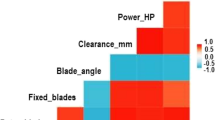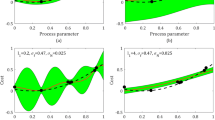Abstract
The research presented in this study deals with the analysis, modeling, and optimization of thermal effects in the creep-feed grinding process. Advanced grinding technology is investigated, which is defined as an extreme production process accompanied by large amounts of interface thermal energy, which results in a heat-affected zone of the workpiece. An optimal control problem based on the conjugate gradient method was used. The optimal control approach simulated heat flux distribution in grinding for selected machining conditions based on the measured temperature inside the workpiece. A further goal of the control problem is to optimize the objective function to find the control variables for the desired process state. The optimization algorithm to minimize the objective function was conducted based on the critical heat flux parameters. Namely, by optimizing the relationship between the heating power and duration, the optimum grinding conditions are determined to achieve high productivity and quality. The solution of the gradient-based optimal control problem was obtained by the iterative numerical optimization technique. The results of the optimal heat control problem showed a good agreement with the experimental data.











Similar content being viewed by others
Data availability
The data underlying this paper are available in the paper.
References
Malkin S, Guo C (2008) Grinding technology: theory and application of machining with abrasives. Industrial Press Inc, New York
Rowe W (2013) Principles of modern grinding technology. William Andrew Publishing, New York
Ozturk S (2018) Grinding of flat glass with Fe- and Cu-based diamond tools. Proc Inst Mech Eng Part B J Eng Manuf 227:102–108. https://doi.org/10.1177/0954405416673113
Kopac J, Krajni P (2006) High-performance grinding – a review. J Mater Process Technol 175:278–284. https://doi.org/10.1016/j.jmatprotec.2005.04.010
Tawakoli T (1993) High efficiency deep grinding. VDI-Verlag and Mechanical Engineering Publications, London
Wasif M, Iqbal SA, Ahmed A et al (2019) Optimization of simplified grinding wheel geometry for the accurate generation of end-mill cutters using the five-axis CNC grinding process. Int J Adv Manuf Technol 105:4325–4344. https://doi.org/10.1007/s00170-019-04547-8
Gu Y, Li H, Du B, Ding W (2019) Towards the understanding of creep-feed deep grinding of DD6 nickel-based single-crystal superalloy. Int J Adv Manuf Technol 100:445–455. https://doi.org/10.1007/s00170-018-2686-2
Guo C, Malkin S (1994) Analytical and experimental investigation of burnout in creep-feed grinding. CIRP Ann 43:283–286. https://doi.org/10.1016/S0007-8506(07)62214-8
Gostimirovic M, Sekulic M, Kopac J, Kovac P (2011) Optimal control of workpiece thermal state in creep-feed grinding using inverse heat conduction analysis. Stroj vestn - J Mech Eng 57:730–738. https://doi.org/10.5545/sv-jme.2010.075
Zhu X, Wang W, Jiang R, Liu X, Lin K (2020) Performances of Ni3Al-based intermetallic IC10 in creep-feed grinding. Int J Adv Manuf Technol 108:809–820. https://doi.org/10.1007/s00170-020-05408-5
Salmon SC (1979) Creep-feed surface grinding. University of Bristol, England
Albert M (1982) Taking the creep out of creep-feed grinding. Modern Machine Shop 80–87
Webster J, Brinksmeier E, Heinzel C, Wittman M, Thoens K (2002) Assessment of grinding fluid effectiveness in continuous-dress creep feed grinding. CIRP Ann 48:581–598. https://doi.org/10.1016/S0007-8506(07)61507-8
Heinzel C, Antsupov G (2012) Prevention of wheel clogging in creep-feed grinding by efficient tool cleaning. CIRP Ann 61:323–326. https://doi.org/10.1016/j.cirp.2012.03.056
Rouly E, Bauer RJ, Warkentin A (2017) An investigation into the effect of nozzle shape and jet pressure in profile creep-feed grinding. Proc Inst Mech Eng Part B J Eng Manuf 231:1116–1130. https://doi.org/10.1177/0954405415584960
Kim HJ, Kim NK, Kwak JS (2006) Heat flux distribution model by sequential algorithm of inverse heat transfer determining workpiece temperature in creep feed grinding. Int J Mach Tools Manuf 46:2086–2093. https://doi.org/10.1016/j.ijmachtools.2005.12.007
Vidal G, Ortega N, Bravo H, Dubar M, González H (2018) An analysis of electroplated cBN grinding wheel wear and conditioning during creep feed grinding of aeronautical alloys. Metals 8:350. https://doi.org/10.3390/met8050350
Li BK, Miao Q, Li M et al (2020) An investigation on machined surface quality and tool wear during creep feed grinding of powder metallurgy nickel-based superalloy FGH96 with alumina abrasive wheels. Adv Manuf 8:160–176. https://doi.org/10.1007/s40436-020-00305-2
Miao Q, Ding W, Xu J et al (2021) Creep feed grinding induced gradient microstructures in the superficial layer of turbine blade root of single crystal nickel-based superalloy. Int J Extrem Manuf 3:045102. https://doi.org/10.1088/2631-7990/ac1e05
Taylor FW (1907) On the art of cutting metals. Trans ASME 29:231–248
Alden GI (1914) Operation of grinding wheels in machine grinding. Trans ASME 36:451–460
Guest JJ (1915) Theory of grinding with reference to the selection of speeds in plain and internal work. Proc Inst Mech Eng 89:543–590
Chapman WH (1920) Cylindrical grinding in 1920. Trans Am Soc Mech Engrs 42:595–620
Dall AH (1946) Rounding effect in centerless grinding. Mech Eng 4:325–329
Marshall ER, Shaw MC (1952) Forces in dry surface grinding. Trans ASME 74:51–59
Outwater JO, Shaw MC (1952) Surface temperatures in grinding Trans ASME 74:73–81
Peklenik J (1964) Contribution to the theory of surface characterization. CIRP Ann 12:173–176
Malkin S (1981) Grinding cycle optimization. CIRP Ann 30:223–226. https://doi.org/10.1016/S0007-8506(07)60930-5
Tönshoff HK, Peters J, Inasaki I, Paul T (1992) Modelling and simulation of grinding processes. CIRP Ann 41:677–688. https://doi.org/10.1016/S0007-8506(07)63254-5
Brinksmeier E, Tönshoff HK, Czenkusch C, Heinzel C (1998) Modelling and optimization of grinding processes. J Intell Manuf 9:303–314. https://doi.org/10.1023/A:1008908724050
Sedighi M, Afshari D (2010) Creep feed grinding optimization by an integrated GA-NN system. J Intell Manuf 21:657–663. https://doi.org/10.1007/s10845-009-0243-4
Zhang ZY, Shang W, Ding HH, Guo J, Wang HY et al (2016) Thermal model and temperature field in rail grinding process based on a moving heat source. Appl Therm Eng 106:855–864. https://doi.org/10.1016/j.applthermaleng.2016.06.071
Agarwal S, Dandge SS, Chakraborty S (2020) Parametric analysis of a grinding process using the rough sets theory. FU Mech Eng 18:91–106. https://doi.org/10.22190/FUME191118007A
Khalilpourazari S, Khalilpourazary S (2020) Optimization of time, cost and surface roughness in grinding process using a robust multi-objective dragonfly algorithm. Neural Comput Appl 32:3987–3998. https://doi.org/10.1007/s00521-018-3872-8
Madic M, Gostimirovic M, Rodic D, Radovanovic M, Coteata M (2022) Mathematical modelling of the CO2 laser cutting process using genetic programming. FU Mech Eng. https://doi.org/10.22190/FUME210810003M
Ozturk S, Kahraman MF (2019) Modeling and optimization of machining parameters during grinding of flat glass using response surface methodology and probabilistic uncertainty analysis based on Monte Carlo simulation. Measurement 145:274–291. https://doi.org/10.1016/j.measurement.2019.05.098
Kahraman MF, Ozturk S (2019) Experimental study of newly structural design grinding wheel considering response surface optimization and Monte Carlo simulation. Measurement 147:106825. https://doi.org/10.1016/j.measurement.2019.07.053
Kahraman MF, Ozturk S (2019) Uncertainty analysis of cutting parameters during grinding based on RSM optimization and Monte Carlo simulation. Mater Test 61:1215–1219. https://doi.org/10.3139/120.111443
Wang Z, Zhang T, Yu T, Zhao J (2020) Assessment and optimization of grinding process on AISI 1045 steel in terms of green manufacturing using orthogonal experimental design and grey relational analysis. J Clean Prod 253:119896. https://doi.org/10.1016/j.jclepro.2019.119896
Pontryagin LS, Boltayanskii VG, Gamkrelidze RV, Mishchenko EF (1962) The mathematical theory of optimal processes. John Wiley & Sons, New York
Guinn T (1976) Reduction of delayed optimal control problems to nondelayed problems. J Optim Theory Appl 18:371–377. https://doi.org/10.1007/BF00933135
Jajarmi A, Pariz N, Effati S, Vahidian Kamyad A (2012) Infinite horizon optimal control for nonlinear interconnected large-scale dynamical systems with an application to optimal attitude control. Asian J Control 14:1239–1250. https://doi.org/10.1002/asjc.452
Betts JT (1998) Survey of numerical methods for trajectory optimization. J Guid Control Dyn 21:193–207. https://doi.org/10.2514/2.4231
Hestenes MR, Stiefel E (1952) Method of conjugate gradient for solving linear systems. J Res Natl Bur Stand 5:409–436. https://doi.org/10.6028/jres.049.044
Fletcher R, Reeves C (1964) Function minimization by conjugate gradients. Comput J 7:149–154. https://doi.org/10.1093/comjnl/7.2.149
Lasdon LS, Mitter SK, Waren AD (1967) The conjugate gradient method for optimal control problems. IEEE Trans Autom Control 12:132–138. https://doi.org/10.1109/TAC.1967.1098538
Quintana VH, Davison EJ (1974) Clipping-offgradient algorithms to compute optimal controls 461 with constrained magnitude. Int J Control 20:243–255
Koivo HN, Mayorga RV (1978) A robust conjugate-gradient algorithm for optimal control problems. Preprints of 7th Congress of IFAC:1093–1100, Pergamon Press, Oxford
Koren Y, Ben-Uri J (1973) Flank-wear model and optimization of machining process and its control in turning. Proc Inst Mech Eng 187:301–307. https://doi.org/10.1243/PIME_PROC_1973_187_112_02
Butt R (1993) Optimum design with finite elements: design of electrochemical machining. J Comput Appl Math 47:151–165. https://doi.org/10.1016/0377-0427(93)90002-S
Yan MT (2010) An adaptive control system with self-organizing fuzzy sliding mode control strategy for micro wire-EDM machines. Int J Adv Manuf Technol 50:315–328. https://doi.org/10.1007/s00170-009-2481-1
Gostimirovic M, Sekulic M, Trifunovic M, Madic M, Rodic D (2021) Stability analysis of the inverse heat transfer problem in the optimization of the machining process. Appl Therm Eng 195:117174. https://doi.org/10.1016/j.applthermaleng.2021.117174
Tikhonov AN, Arsenin VY (1977) Solution of ill-posed problems. Winston & Sons, Washington
Alifanov OM (1994) Inverse heat transfer problems. Springer, Berlin
Colaco MJ, Orlande HRB, Dulikravich GS (2006) Inverse and optimization problems in heat transfer. J Braz Soc Mech Sci Eng 28:1–24. https://doi.org/10.1590/S1678-58782006000100001
Polak E, Ribière G (1969) Note Sur la Convergence de Méthodes de Directions Conjuguées. Revue Francaise d’Informatique et de Recherche Opérationnelle 16:35–43
Jaeger JC (1942) Moving sources of heat and temperature at sliding contacts. Proc R Soc NSW 76:203–224
Gostimirovic M, Kovac P, Sekulic M (2011) An inverse heat transfer problem for optimization of the thermal process in machining. Sadhana - Acad P Eng S 36:489–504. https://doi.org/10.1007/s12046-011-0034-4
Funding
This paper presents a part of researching at the Project No. 451–03-68/2020–14/200156 financed by Ministry of Education, Science and Technological Development of the Republic of Serbia.
Author information
Authors and Affiliations
Contributions
M. Gostimirovic conceived of the presented idea, developed the theory, methodology, software, and wrote original draft. M. Madic verified the mathematical model and helped shape the research, analysis, and design. M. Sekulic supervised the findings of this work and provided critical feedback. D. Rodic and A. Aleksic conceived and planned the experiments and performed the necessary measurements.
Corresponding author
Ethics declarations
Ethics approval
Not applicable.
Consent to participate
This paper is approved by all authors, as well as by the responsible authorities at the Faculty of Technical Science.
Consent for publication
The paper has not been previously published and is not under consideration for publication elsewhere.
Competing interests
The authors declare no competing interests.
Additional information
Publisher's note
Springer Nature remains neutral with regard to jurisdictional claims in published maps and institutional affiliations.
Rights and permissions
About this article
Cite this article
Gostimirovic, M., Madic, M., Sekulic, M. et al. A gradient-based optimal control problem in creep-feed grinding. Int J Adv Manuf Technol 121, 4777–4791 (2022). https://doi.org/10.1007/s00170-022-09609-y
Received:
Accepted:
Published:
Issue Date:
DOI: https://doi.org/10.1007/s00170-022-09609-y




